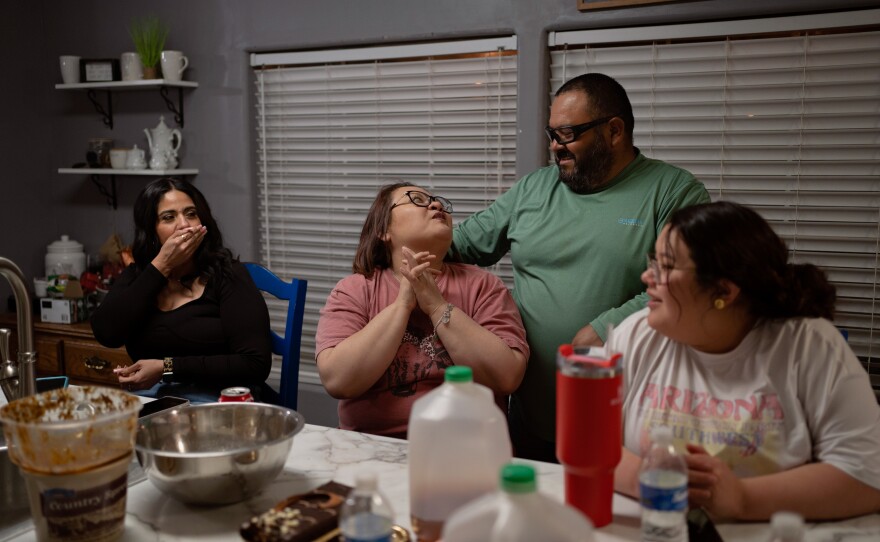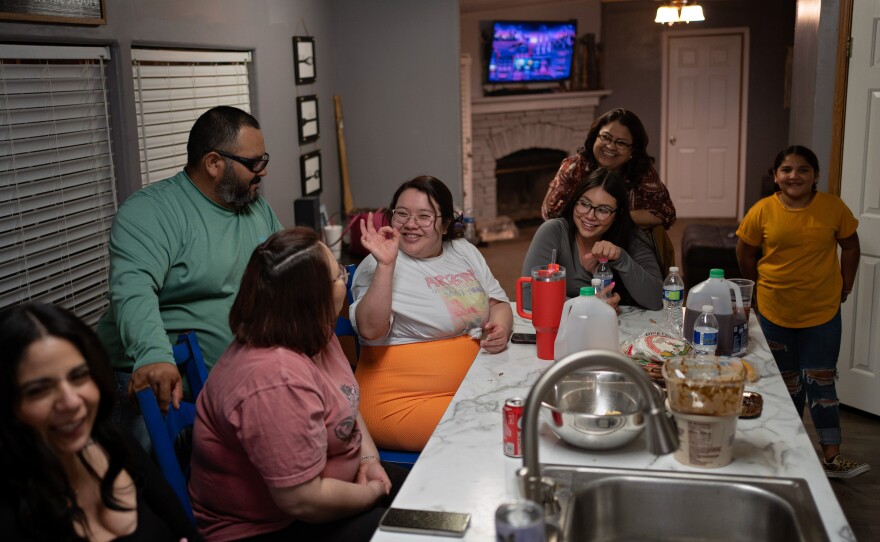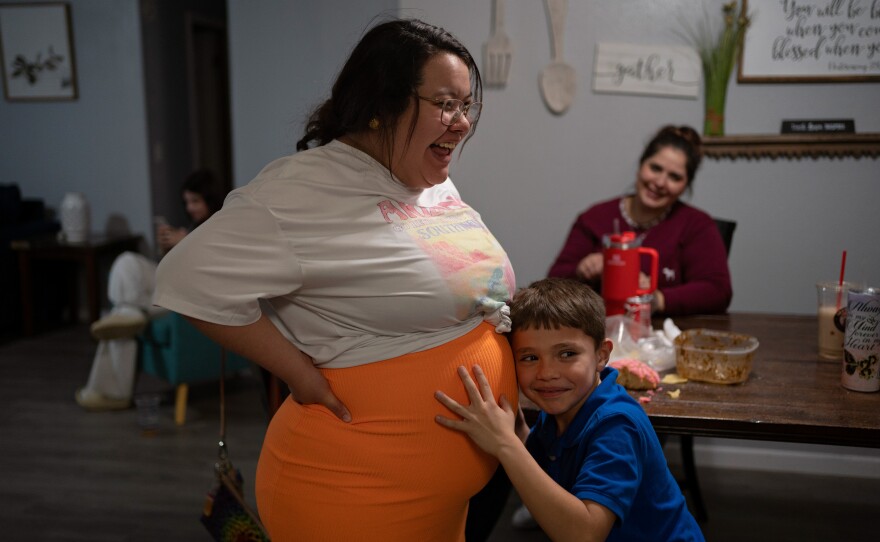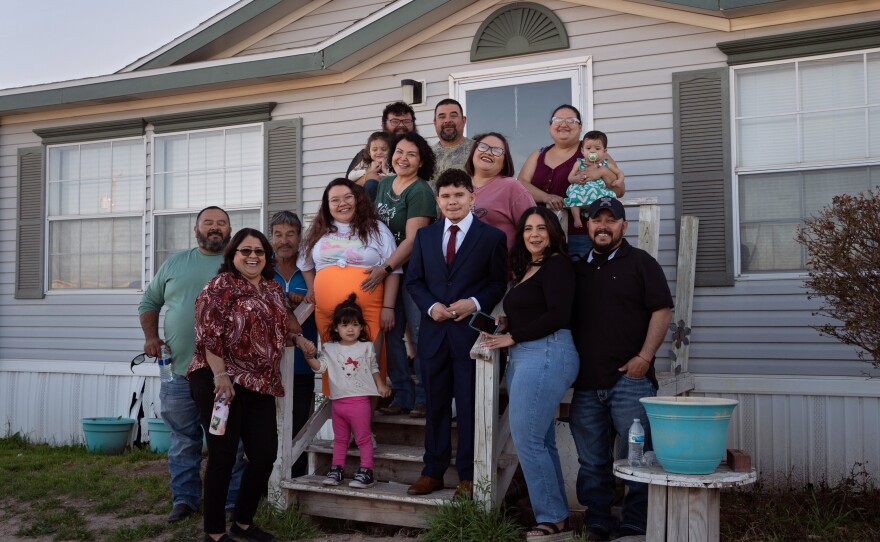The Science of Siblings is a new series exploring the ways our siblings can influence us, from our money and our mental health all the way down to our very molecules. We'll be sharing these stories over the next several weeks.
Back in college, Caitlynn Almance remembers one time her little sister called her up and asked her if she could borrow a pair of boots for a high school event.
But there was one big problem: Caitlynn went to college in a town two hours away from her family in Odessa, Texas. To deliver the boots, she'd have to drive two hours each way.

Caitlynn didn't hesitate. "I had only a four-hour break between classes and theater rehearsal, so I drove all the way down to Odessa, dropped off the boots at the front door and drove all the way back to school," Caitlynn says. "It's because my sister needed them."
To say Caitlynn cares for — and loves — her little sister would be a huge understatement. "My sister is my best friend in the entire world, and I tell people that all the time," she says proudly. "I don't think I could make it day to day without her. She's the person I turn to for everything."
This genuine love and kindness doesn't stop with her sister. She feels the same about her little brother, who's also still in high school. A few years ago, she seriously considered moving with him to Los Angeles to help support him financially during college.
"I was like, 'Look, Eddie, if that's what you really want to do, I'll pick up my life and I'll move over there. I'll get a job to support you while you go to college,''" she remembers. "Because I know how hard it was for me to work and go to college at the same time. So if he doesn't have to do that, then I wouldn't want him to do that."
Caitlynn's mom, Cindy Almance, says her four children rarely fight. "Even at such a young age, their grandma was constantly telling them, 'You never fight,'" she says. "So even as teenagers, the girls didn't fight."
Over the past few decades, psychologists have begun to understand how parents, across many cultures, teach their children to build these deep, fulfilling relationships with their siblings. How parents teach their children to be kind to and care for their brothers and sisters.
Psychologist Belinda Campos has been researching this question in families with East Asian, European and Latino heritage. "As far as Latinos go, studies have looked at how parents intentionally teach children to focus on and prioritize family over themselves."
In fact, Campos says, scientists can actually see — inside the brains of young Latinos — what parents are teaching their children.
A revealing game about money
Back in the late 2000s, developmental psychologists at the University of California, Los Angeles brought 25 young adults from two cultural groups into the laboratory. Eleven participants identified as European American and 14 participants identified as Latino. Their average age was about 20 years old.
The scientists had the volunteers play a game: The young adults had to decide whether to help a family member who needed money. In the game, they also received money themselves. During these transactions, the scientists analyzed the participants' brains.

Both Latino and European American participants equally assisted their family members who needed help. But what happened inside the reward center of the brain, which helps us feel pleasure and joy, was quite different.
The reward center of the European Americans' brains lit up much more when they received money themselves compared to when they gave money to their family members. The reverse occurred in the brains of Latino participants: Their reward centers lit up more when they gave money to their family compared to when they received money.
"So the Latino participants weren't only assisting their family members, but they were also finding it pleasurable and rewarding," Campos says. "I think those findings make such a compelling argument that some of us find the act of giving to others really rewarding because we've been socialized to."
This study was small, but many other studies since then back up this key finding, Campos says. For example, researchers at the University of California, Riverside have found, repeatedly, that people feel better when they do something kind for another person versus doing something kind for themselves. "When we place our focus on others, it seems to generate its own momentary joys," Campos says. "But it also seems to deflect from whatever may be bringing us down."
In other words, to raise children who care deeply about their siblings, many parents teach children not only how to be kind to their family but also to want to be kind. They teach that caring is a major source of joy.
So helping your little sister or brother isn't this burden or obligation. Rather it's a part of your life that makes you feel good.
"It's about enjoyment and relations that provide happiness," says behavioral economist Mariano Rojas at Mexico's Technological Institute. "It gives children what I call relational wealth."
And this relational wealth, Rojas has found, has massive repercussions for Latino communities across North and South America.

For the past decade, Rojas has been trying to figure out why people in Latin American countries score so high on surveys about happiness and life satisfaction. "If you go to the World Values Survey, which has like 170 countries, you will find that Latin American countries, on average, are the happiest ones in the world," he says.
This fact surprises many scientists, Rojas says, because Latin American countries, on average, are much poorer and have more inequality and violence than European countries. "Latin Americans are very happy, and it's really not something you'd expect given their economic situation."
His research suggests that this happiness comes from Latinos' relational wealth. "It's not because relationships give people social or economic support," he explains. "That's a mistake many psychologists make while talking about relationships and happiness. What's key is enjoying your family."
Calling every day
The sun has just set over the dry, west Texas prairie. It's around dinnertime on a warm Saturday evening. Inside a little ranch house, the Almance family is doing what they do almost every day. They're gathered around the kitchen island telling stories. There's Caitlynn's grandmother, her parents, an aunt and an uncle.
Caitlynn's mom, Cindy, tells a story about traveling with her mother-in-law right after she got married. As she tells the punchline, the whole crowd erupts in loud laughter.
Then I ask Cindy the same question I posed to scientists: How do you teach children to find joy in helping their siblings?
And she answers exactly the same as the scientists answered. "We model it," Cindy says.
Cindy models not just helping her siblings, but also the joy she receives from the relationships she has with her brothers and sisters. "It's a close, close bond," she says. Even after some of her siblings left Odessa, Cindy still loves to talk to them on the phone. "Every single day, at 6:30 in the morning, on my way to work. I'm already talking to them."
And Caitylnn not only notices these calls, she joins them. "My mom's older sister and her family live in a different time zone than we do, so they have to wake up an hour earlier than their day would start, just so we could have that daily dose [of sibling love] before we get to work."
Caitlynn's grandmother, Dora, says this modeling dates back at least seven generations. So it's a value transmitted and strengthened over time. "The older generations taught us that helping each other keeps the family together," Dora adds.
"It's a chain reaction," Cindy says. "It keeps going from one generation to the next."

And what happens if a sibling doesn't pull their weight or doesn't want to keep up the family tradition of joyful helping?
The family tries to pull them into the fold, says Caitlynn's aunt, Lisset Almance. "We never put people down," she says. "If that person's down, we try to cheer him up. We'll say, 'Hey, what's wrong? Don't you know how much the family loves you?'"
Perhaps most important, Caitlynn says, is that her family enjoys being together. Almost every day, multiple generations of brothers and sisters come together. "This is like your everyday people," Caitlynn says. "And they have such an everyday impact on my life. We don't search each other up on Facebook because we know each other well."
And now, Caitlynn is going to add the next generation of siblings. She's expecting her first child this summer. And she's already talking about having a second baby. "This one isn't even out yet, but I'm like, let's hurry up and make another one," she exclaims.
Why? Because she wants her baby to have a sibling right away. "The bond I have with my siblings — and the bond my siblings have with each other — it's just the most beautiful bond ever. I just can't imagine my child growing up without that."
Your turn: Tell us about your relationship with a sibling
Do you have a close relationship with a sibling or siblings? Why do you think you are so close? And can you share an example of a special time that your sibling helped you out — or that you helped out your sibling? Email us at goatsandsoda@npr.org with the subject line "Sibling ties." We may feature your strategy on NPR.org. Please include your name and location. Submissions close on Monday, April 29.
More from the Science of Siblings series:
- Gay people often have older brothers. Why? And does it matter?
- A gunman stole his twin from him. This is what he's learned about grieving a sibling
- In the womb, a brother's hormones can shape a sister's future
- These identical twins both grew up with autism, but took very different paths
Copyright 2024 NPR. To see more, visit https://www.npr.org. 9(MDAzMjM2NDYzMDEyMzc1Njk5NjAxNzY3OQ001))







